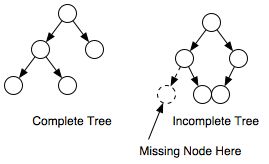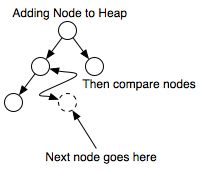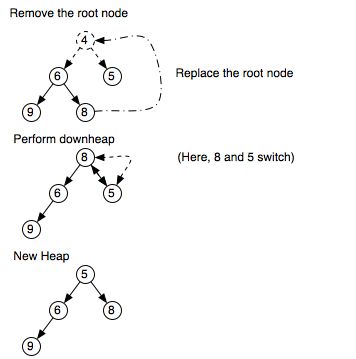What is a heap?--reference
A heap is a partially sorted binary tree. Although a heap is not completely in order, it conforms to a sorting principle: every node has a value less (for the sake of simplicity, we will assume that all orderings are from least to greatest) than either of its children. Additionally, a heap is a "complete tree" -- a complete tree is one in which there are no gaps between leaves. For instance, a tree with a root node that has only one child must have its child as the left node. More precisely, a complete tree is one that has every level filled in before adding a node to the next level, and one that has the nodes in a given level filled in from left to right, with no breaks.

Why use a heap?
A heap can be thought of as a priority queue; the most important node will always be at the top, and when removed, its replacement will be the most important. This can be useful when coding algorithms that require certain things to processed in a complete order, but when you don't want to perform a full sort or need to know anything about the rest of the nodes. For instance, a well-known algorithm for finding the shortest distance between nodes in a graph, Dijkstra's Algorithm, can be optimized by using a priority queue.
Heaps can also be used to sort data. A heap sort is O(nlogn) efficiency, though it is not the fastest possible sorting algorithm. Check out thistutorial heap sort for more information related to heap sort.
How do you implement a heap?
Although the concept of a heap is simple, the actual implementation can appear tricky. How do you remove the root node and still ensure that it is eventually replaced by the correct node? How do you add a new node to a heap and ensure that it is moved into the proper spot?
The answers to these questions are more straight forward than meets the eye, but to understand the process, let's first take a look at two operations that are used for adding and removing nodes from a heap: upheaping and downheaping.
Upheap: The upheap process is used to add a node to a heap. When you upheap a node, you compare its value to its parent node; if its value is less than its parent node, then you switch the two nodes and continue the process. Otherwise the condition is met that the parent node is less than the child node, and so you can stop the process. Once you find a parent node that is less than the node being upheaped, you know that the heap is correct--the node being upheaped is greater than its parent, and its parent is greater than its own parent, all the way up to the root.
Downheap: The downheap process is similar to the upheaping process. When you downheap a node, you compare its value with its two children. If the node is less than both of its children, it remains in place; otherwise, if it is greater than one or both of its children, then you switch it with the child of lowest value, thereby ensuring that of the three nodes being compared, the new parent node is lowest. Of course, you cannot be assured that the node being downheaped is in its proper position -- it may be greater than one or both of its new children; the downheap process must be repeated until the node is less than both of its children.
 When you add a new node to a heap, you add it to the rightmost unoccupied leaf on the lowest level. Then you upheap that node until it has reached its proper position. In this way, the heap's order is maintained and the heap remains a complete tree.
When you add a new node to a heap, you add it to the rightmost unoccupied leaf on the lowest level. Then you upheap that node until it has reached its proper position. In this way, the heap's order is maintained and the heap remains a complete tree.
 Removing the root node from a heap is almost as simple: when you take the node out of the tree, you replace it with "last" node in the tree: the node on the last level and rightmost on that level.
Removing the root node from a heap is almost as simple: when you take the node out of the tree, you replace it with "last" node in the tree: the node on the last level and rightmost on that level.
Once the top node has been replaced, you downheap the node that was moved until it reaches its proper position. As usual, the result will be a proper heap, as it will be complete, and even if the node in the last position happens to be the greatest node in the entire heap, it will do no worse than end up back where it started.
Efficiency of a heap
Whenever you work with a heap, most of the time taken by the algorithm will be in upheaping and downheaping. As it happens, the maximum number of levels of a complete tree is log(n)+1, where n is the number of nodes in the tree. Because upheap or downheap moves an element from one level to another, the order of adding to or removing from a heap is O(logn), as you can make switches only log(n) times, or one less time than the number of levels in the tree (consider that a two level tree can have only one switch).
reference from :http://www.cprogramming.com/tutorial/computersciencetheory/heap.html
What is a heap?--reference的更多相关文章
- (C#) Interview Questions.
(Note: Most are collected from Internet. 绝大部分内容来自互联网) 1. What's the difference between Hashtable and ...
- 11.Events
1.A type that defines an event member allows the type (or instances of the type) to notify other obj ...
- OpenJDK与HashMap
OpenJDK的非堆JDK增强提议(JDK Enhancement-Proposal,JEP)试图标准化一项基础设施,它从Java6开始,只能在HotSpot和OpenJDK内部使用.这种设施能够像管 ...
- MySQL :: MySQL 5.0 Reference Manual :: 14.4 The MEMORY (HEAP) Storage Engine
MySQL :: MySQL 5.0 Reference Manual :: 14.4 The MEMORY (HEAP) Storage Engine The MEMORY (HEAP) Stora ...
- Java 堆内存与栈内存异同(Java Heap Memory vs Stack Memory Difference)
--reference Java Heap Memory vs Stack Memory Difference 在数据结构中,堆和栈可以说是两种最基础的数据结构,而Java中的栈内存空间和堆内存空间有 ...
- Chrome-Console( Command Line API Reference)
来源于:https://developers.google.com/web/tools/chrome-devtools/console/command-line-reference The Comma ...
- CLR via C# 3rd - 05 - Primitive, Reference, and Value Types
1. Primitive Types Any data types the compiler directly supports are called primitive types. ...
- heap c++ 操作 大顶堆、小顶堆
在C++中,虽然堆不像 vector, set 之类的有已经实现的数据结构,但是在 algorithm.h 中实现了一些相关的模板函数.下面是一些示例应用 http://www.cplusplus.c ...
- strong reference cycle in block
However, because the reference is weak, the object that self points to could be deallocated while th ...
随机推荐
- ejabberd的多域名(domain)设置
在ejabberd中可以支持多个domain,我讲一下我的配置过程我的ejabberd系统是:ejabberd server+sql server+openldap+gateway.我总共使用了5台机 ...
- Web网站常规测试方法
功能测试 1. 安装测试: 安装过程中对于缺省安装目录及任意指定的安装目录,是否都能正确安装: 若是选择安装,查看能否实现其相应的功能: 在所有能中途退出安装的位置退出安装程序后,验证此程序并未安装成 ...
- 使用C语言实现二维,三维绘图算法(2)-解析曲面的显示
使用C语言实现二维,三维绘图算法(2)-解析曲面的显示 ---- 引言---- 每次使用OpenGL或DirectX写三维程序的时候, 都有一种隔靴搔痒的感觉, 对于内部的三维算法的实现不甚了解. 其 ...
- 依赖注入框架Autofac源码阅读指南
官方网站http://autofac.org/ 源码下载地址https://github.com/autofac/Autofac 最新版本是3.5.0 下载后大小为37M,包括源码,示例文档,与之相关 ...
- 题解西电OJ (Problem 1006 - 转盘游戏)--动态规划
题目链接 : http://acm.xidian.edu.cn/land/problem/detail?problem_id=1006 Description wm最近喜欢上一种无聊的转盘解锁游戏,他 ...
- 关于mac 80端口问题
使用 maven启动 jettry时 ,jetty使用的是80端口 ,但是 mac 在1024以下的端口似乎是不让随便使用的. 在网上查了好多方式,其中的一种说是做端口转发,其实也就是把80转换成别的 ...
- mac 学习
1. 下载下来的eclipse,想把eclipse的图标放到applications目录里 做法:将下载的eclipse 的gz 文件直接移动到 /Applications 文件夹下 ,解压后即可在 ...
- Eclipse安装ADT插件
安卓开发环境搭建,如果选择的是ADT Bundle,则包含了eclipse和adt tools.但是有些时候是在已经独立安装了Eclipse的基础上,在线安装ADT插件,就稍微麻烦了. 一.在线安装A ...
- HDU1710Binary Tree Traversals
HDU1710Binary Tree Traversals 题目大意:给一个树的前序遍历和中序遍历,要求输出后序遍历. (半年前做这道题做了两天没看懂,今天学了二叉树,回来AC了^ ^) 首先介绍一下 ...
- Spark生态之Spark BlinkDB
